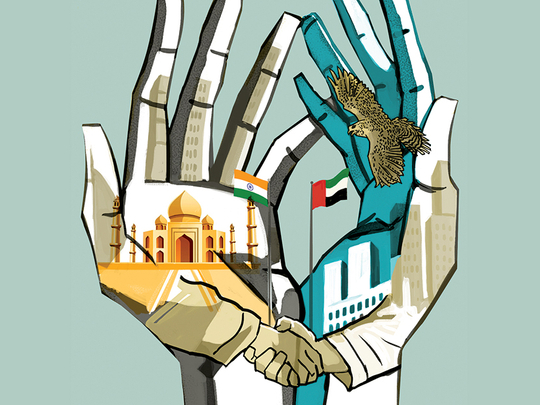
On October 2, the birth anniversary of its Father of the Nation, Mahatma Gandhi, India announced that His Highness Shaikh Mohammad Bin Zayed Al Nahyan, Abu Dhabi Crown Prince and Deputy Supreme Commmander of the UAE Armed Forces, will be the Chief Guest at the next Indian Republic Day celebrations on January 26, 2017.
The announcement came nearly four months ahead of the event.
The chief guest on Republic Day is the highest level of protocol accorded by India to a foreign dignitary. The visiting dignitary normally arrives on the evening of January 24 for him or her to be hosted at the Presidential Palace in New Delhi.
The official itinerary includes summit-level talks on that day, followed by a presidential banquet the next day. The two-hour military and cultural parade on the morning of January 26 — marked by much pomp and pageantry — is the high point of the visit.
This is followed by a multi-day tour of selected sites in India by the visiting dignitary.
As India gained political clout and economic stature over the years, a string of statesmen have been extended this honour of being the chief guest at the Republic Day parade.
During the past decade, chief guests in New Delhi on January 26 have included dignitaries such as the late Saudi King Abdullah Bin Abdul Aziz (2006), Russian President Vladimir Putin (2007), former French president Nicolas Sarkozy (2008), United States President Barack Obama (2015) and current French President Francois Hollande (2016).
The selection of guests reflects New Delhi’s assessment of a certain country’s importance to India, the orientation of the leader to be invited toward India and the likely impact of the visit.
Given these criteria, the selection of Shaikh Mohammad for this honour is only natural. Since August 2015, when Indian Prime Minister Narendra Modi visited the UAE, Shaikh Mohammad has partnered Modi to redefine bilateral ties and put them in a higher trajectory.
Bilateral gains
Shaikh Mohammad’s return visit to India in February 2016 further consolidated the bilateral gains.
The two summits were noteworthy for the exceptional warmth shared by the two leaders and their willingness to foster a strategic partnership, leveraging their shared history, geographic proximity and socio-economic complementarity in a calibrated and sustained manner.
The two sides have done well to concentrate on bilateral economic and social domains.
These energetic attempts to give a new fillip to UAE-India relations have faced some strong headwinds such as lower oil prices, respective sub-regional distractions and global economic stagnation.
However, despite these pitfalls, considerable progress has been achieved by the two countries.
Undoubtedly, the decline in commodity prices has affected the value of bilateral trade. Nevertheless, the momentum has begun to stabilise and turn around.
For instance, after falling by 15.7 per cent in 2015, the decline in UAE-India trade was limited to 3.7 per cent during the first half of 2016, when it stood at more than $25 billion (Dh91.95 billion).
In fact, Indian exports registered a 2.4 per cent growth. More significantly, the UAE continues to be India’s third-largest trading partner and the second-largest export market, while India is the UAE’s largest trading partner.
Nevertheless, with bilateral trade off a third from its peak in 2012-13, the August 2015 summit’s target of raising bilateral trade by 60 per cent by 2020 now appears to be a daunting challenge. So, new growth engines need to be identified and deployed.
A valuable opportunity
The global economic slowdown has not affected people-to-people contacts. The Indian diaspora’s presence in the UAE and their homebound remittances continue to be largely stable. Dubai is still the foreign city most visited by Indians. Mutual investments, too, have been rising. Indians continue to be the biggest foreign buyers of real estate in Dubai as well as the largest investors in the various free zones in the UAE.
At the same time, the UAE Foreign Portfolio Investment in India stood at $8.57 billion in June 2016. Similarly, foreign direct investment (FDI) from the UAE to India has nearly quadrupled in the past three Indian financial years to $985 million in 2015-2016.
In other words, despite a surge in UAE investments into India, only 1 per cent of UAE’s global foreign investments are parked there.
Given such a scenario, Shaikh Mohammad’s impending state visit to India is very significant — both symbolically and substantially. Apart from raising the bilateral ties to a new level, it affords the two sides a valuable opportunity to renew their mutual adherence and review the progress achieved during the past 18 months.
While the mutual goodwill quotient is higher than ever and bilateral indicators have improved steadily, the awaited quantum leap is yet to materialise.
There is still scope for further strengthening of ties and bolstering of mutual cooperation in areas such as hydrocarbon links, tie-ups in civil aviation and maritime sectors, semiconductor fabrication facilities, India’s participation in the UAE’s Mars probe and aggregating defence co-production. Flagship UAE investments in India’s National Infrastructure Investment Fund have also been on the anvil.
Given the specifics of the two socio-economies, some of these steps may require out-of-box thinking. Moreover, the resolution of so-called legacy issues would help smooth this process.
The forthcoming visit by Shaikh Mohammad will certainly be a historic event. However, its success would lie as much in the IAF flypasts above the Janpath boulevard as in a bilateral strategic partnership taking off.
Mahesh Sachdev is a retired Indian diplomat. His book UAE: A Business Manual was published last month.












